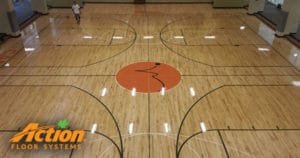
Users and spectators are likely to only ever see the top of the maple floor boards beneath their feet. However, the quality of a sports surface isn’t just determined by the finished floor, but rather the supporting layers that make up the flooring system.
Selecting the right subfloor system for your sports floor takes careful consideration and ultimately depends on the functions and activities that will take place in the space. For example, an auxiliary (multifunction) gym or aerobic studio is likely going to require different performance characteristics than a game performance gymnasium used for volleyball or basketball competitions.
Age and performance level of users can also be a determining factor. Because their bones and joints are still growing and their muscles are not as developed, young children may benefit from a sports floor that has higher shock absorption to minimize injuries and reduce impact.
Elite-level athletes may excel on a firmer sports floor that has less shock absorption, however, they may also benefit from a performance floor that delivers uniformity, shock absorption, and controlled deflection to assist in reducing potential injuries. Ultimately, the type of floor that best meets the needs of a college or professional athlete depends on the activity being performed.
Aside from a floor’s purpose, project type can influence the selection process. An existing facility looking to breathe new life into a sports surface may have different criteria for what the floor must accomplish versus new construction.
When considering permanent hardwood floor systems for your facility, there are two floor system options you should consider: anchored resilient and floating resilient. Both systems have advantages, and understanding their attributes will help guide your decision.
Anchored Resilient Floor Systems
Anchored resilient floor systems feature a subfloor that is anchored to the concrete. Anchoring or retaining the subfloor prevents the floor system from excessive vertical deflection. Anchored resilient floor systems are often recommended today for new construction jobs because of their optimal performance-based surface for athletes of all ages.
A Winning Combination of Stability and Resilience
One of the unique features of anchored resilient systems is the resiliency and uniformity the subfloor provides athletes across the entire floor system.
“Most newer generation anchored resilient floor systems move laterally. They do not impede the natural seasonal expansion and contraction across the concrete slab. Retaining the vertical deflection helps keep it controlled so the uniformity of play is maintained,” says Don Brown, technical director of Action Floor Systems®.
Certain anchored systems, like the Action PowerChannel, use an anchored steel channel to keep layers of plywood in place while allowing the system to slide in response to expansion or contraction caused by natural seasonal changes in a facility’s relative humidity levels.
Because the floor is retained, athletes can expect exceptional uniformity, stability, ball bounce, and shock absorption because of the engineering in the retained design.
Superior Athletic Performance
In addition to controlling the vertical deformation or travel of the subfloor system, anchored resilient floors can also help reduce unwanted vibration, which studies have indicated are critical in limiting muscle soreness in athletes. Competition basketball gymnasiums may benefit from an anchored resilient subfloor, as this system group typically produces consistent and uniform ball bounce.
Because anchored resilient systems are fastened to the concrete, the possibility of dead spots forming is greatly minimized as the playing surface is more likely to remain even.
Floating Resilient Floor Systems
Floating resilient systems are installed in a wide variety of facilities ranging from performance floors to auxiliary gyms, multipurpose spaces, elementary schools, and practice gymnasiums. In floating resilient systems, the subfloor is not fastened to the concrete, but rather the floor system rests on top of the concrete slab.
Resilient Padding for Uniform Performance
Although subfloor pads are included in both anchored resilient and floating systems, rubber and foam resilient pads enhance the feel of shock absorption in floating resilient systems. Because many schools and recreational facilities install floating resilient systems for athletic purposes, shock absorbency is important in minimizing the potential for injury in athletes of all ages.
The floating resilient systems offered by Action Floors® feature foam and natural rubber pad configurations based on performance expectations, as well as the condition and location of the sports floor.
Foam shock pads are also commonly installed in second- or third-story gymnasiums where acoustics can be a problem. The foam padding helps absorb the sound, so it doesn’t travel to lower levels.
Selecting Your Facility’s Sports Flooring System
No matter what flooring system you choose, Action Floors®’ maple sports floor systems are designed to deliver quality performance that can last the life of your facility. From elementary school cafeterias and gymnasiums to collegiate and professional basketball courts, we offer a solution for all your sports flooring needs.
For more information on which anchored or floating resilient maple sports floor system is right for your facility, contact us today. We can also help you get in touch with a local dealer in your area.

























